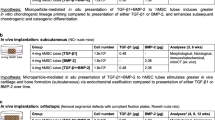Abstract
Tissue engineering of human bone is a complex process, as the functional development of bone cells requires that regulatory signals be temporally and spatially ordered. The role of three-dimensional cellular interactions is well understood in embryonic osteogenesis, but in vitro correlates are lacking. Here we report that in vitro serum-free transforming growth factor (TGF)-β1 stimulation of osteogenic cells immediately after passage results in the formation of three-dimensional cellular condensations (bone cell spheroids) within 24 to 48 hours. In turn, bone cell spheroid formation results in the up-regulation of several bone-related proteins (e.g., alkaline phosphatase, type I collagen, osteonectin) during days 3–7, and the concomitant formation of micro-crystalline bone. This system of ex vivo bone formation should provide important information on the physiological, biological and molecular basis of osteogenesis.
This is a preview of subscription content, access via your institution
Access options
Subscribe to this journal
Receive 12 print issues and online access
$209.00 per year
only $17.42 per issue
Buy this article
- Purchase on Springer Link
- Instant access to full article PDF
Prices may be subject to local taxes which are calculated during checkout







Similar content being viewed by others
References
Lian, J.B. & Stein, G.S. Concepts of osteoblast growth and differentiation: basis for modulation of bone cell development and tissue formation. Crit. Rev. Oral Biol. Med. 3, 269–305 (1992).
Hall, B.K. & Miyake, T. Divide, accumulate, differentiate: cell condensation in skeletal development revisited. Int. J. Dev. Biol. 39, 881–893 ( 1995).
Centrella, M., McMarthy, T.L. & Canalis, E. Transforming growth factor β is a bifunctional regulator of replication and collagen synthesis in osteoblast-enriched cell cultures from fetal rat bone. J. Biol. Chem. 262, 2869–2874 (1987).
Dunlop, L.T. & Hall, B.K. Relationship between cellular condensation, preosteoblast formation and epithelial-mesenchymal interactions in initiation of osteogenesis. Int. J. Dev. Biol. 39, 357–371 (1995).
Denker, A.E., Nicoll, S.B. & Tuan, R.S. Formation of cartilage-like spheroids by micromass cultures of murine C3H10T1/2 cells upon treatment with transforming growth factor-β1. Differentiation 59, 25– 34 (1995).
Wong, M. & Tuan, R.S. Interactive cellular modulation of chondrogenic differentiation in vitro by subpopulations of chick embryonic calvarial cells. Dev. Biol. (Orlando) 167, 130–147 (1995).
Woodward, W.A. & Tuan, R.S. N-Cadherin expression and signaling in limb mesenchymal chondrogenesis: stimulation by poly-L-lysine. Dev. Genet. 24, 178–187 (1999).
Johnstone, B., Hering, T.M., Caplan, A.I., Goldberg, V.M. & Yoo, J.U. In vitro chondrogenesis of bone marrow-derived mesenchymal progenitor cells. Exp. Cell Res. 238, 265–272 (1998).
Yoo, J.U. et al. The chondrogenic potential of human bone-marrow-derived mesenchymal progenitor cells. J. Bone Min. Res. 80, 1745– 1757 (1998).
Johnstone, B. & Yoo, J.U. Autologous mesenchymal progenitor cells in articular cartilage repair. Clin. Ortho. Rel. Res. S156–S162 (1999).
Malaval, L., Modrowski, D., Gupta, A.K. & Aubin, J.E. Cellular expression of bone-related proteins during in vitro osteogenesis in rat bone marrow stromal cell cultures. J. Cell. Physiol. 158, 555–572 (1994).
Timlin, J.A. et al. Spatial distribution of phosphate species in mature bone and newly generated mammalian bone by hyperspectral raman imaging. J. Biomed. Optics 4, 28–34 ( 1999).
Mendelsohn, R., Hassankhani, A., DiCarlo, E. & Boskey, A. FT-IR microscopy of endochondral ossification at 20u spatial resolution. Calcif. Tissue Int. 44, 20–24 (1989).
Long, M.W., Robinson, J.A., Ashcraft, E.A. & Mann, K.G. Regulation of human bone marrow-derived osteoprogenitor cells by osteogenic growth factors. J. Clin. Invest. 95, 881 –887 (1995).
Fang, J. & Hall, B.K. Differential expression of neural cell adhesion molecule (NCAM) during osteogenesis and secondary chondrogenesis in the embryonic chick. Int. J. Dev. Biol. 39, 519–528 (1995).
Gronthos, S., Stewart, K., Graves, S.E., Hay, S. & Simmons, P.J. Integrin expression and function on human osteoblast-like cells. J. Bone Mineral Res. 12, 1189–1197 (1997).
Moursi, A.M., Globus, R.K. & Damsky, C.H. Interactions between integrin receptors and fibronectin are required for calvarial osteoblast differentiation in vitro. J. Cell Sci. 110, 2187–2196 (1997).
Ducy, P. et al. Increased bone formation in osteocalcin-deficient mice. Nature 382, 448–452 ( 1996).
Hunter, G.K., Hauschka, P.V., Poole, A.R., Rosenberg, L.C. & Goldberg, H.A. Nucleation and inhibition of hydroxyapatite formation by mineralized tissue proteins. Biochem. J. 317, 59–64 ( 1996).
Pastoureau, P., Vergnaud, P., Meunier, P.J. & Delmas, P.D. Osteopenia and bone remodeling abnormalities in warfarin-treated lambs. J. Bone Mineral Res. 8, 1417–1426 (1929).
Fedarko, N.S., Vetter, U.K., Weinstein, S. & Robey, P.G. Age-related changes in hyaluronan, proteoglycan, collagen, and osteonectin synthesis by human bone cells. J. Cell. Physiol. 151 , 215–227 (1992).
Franceschi, R.T., Romano, P.R. & Park, K.-Y. Regulation of Type I collagen synthesis by 1,25-dihydroxyvitamin D3 in human osteosarcoma cells. J. Biol, Chem, 263, 18938–18945 (1988).
Towbin, H., Staehelin, T. & Gordon, J. Electrophoretic transfer of proteins from polyacrylamide gels to nitrocellulose sheets: procedure and some applications. Proc. Natl. Acad. Sci. USA 76, 4350– 4354 (1979).
Long, M.W., Williams, J.L. & Mann, K.G. Expression of human bone-related proteins in the hematopoietic microenvironment. J. Clin. Invest. 86, 1387 –1395 (1990).
Acknowledgements
The authors thank Laurie McCauley and Renny Franceschi for careful reading of the manuscript. Supported, in part, by Grants AG 43460 and HL 59495 from the National Institutes of Health.
Author information
Authors and Affiliations
Corresponding author
Rights and permissions
About this article
Cite this article
Kale, S., Biermann, S., Edwards, C. et al. Three-dimensional cellular development is essential for ex vivo formation of human bone. Nat Biotechnol 18, 954–958 (2000). https://doi.org/10.1038/79439
Received:
Accepted:
Issue Date:
DOI: https://doi.org/10.1038/79439
This article is cited by
-
Bone regeneration in rat calvarial defects using dissociated or spheroid mesenchymal stromal cells in scaffold-hydrogel constructs
Stem Cell Research & Therapy (2021)
-
Trabecular bone organoids: a micron-scale ‘humanised’ prototype designed to study the effects of microgravity and degeneration
npj Microgravity (2021)
-
Modeling neoplastic disease with spheroids and organoids
Journal of Hematology & Oncology (2020)
-
Modified parylene-N films as chemical microenvironments for differentiation and spheroid formation of osteoblast cells
Scientific Reports (2020)
-
Growth factor regulatory system: a new system for not truly recognized organisms
Science China Life Sciences (2020)



